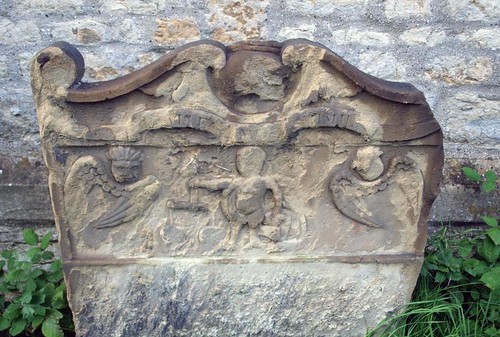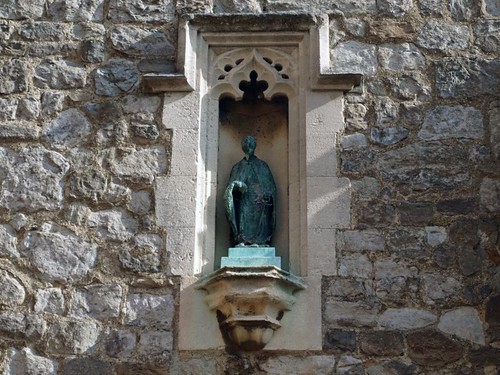ST CLEMENT. High above the sea with steps down to the village High Street by the shore. C15 W tower with diagonal buttresses, W door with shields in the spandrels, three-light W window, battlements and higher stair-turret. C15 N aisle with four-light W window (Perp panel tracery) and three-light N windows, chancel and S side C19. S porch of brick, with thick brick doorway and two-light W and E windows. N arcade of four low bays with octagonal piers and double-hollow-chamfered arches. - STAINED GLASS. C18 Crucifixion, very pictorial, with sinister grey clouds; E window. Chancel S window of two lights with replicas of two of Reynolds’s figures for New College Oxford, with incongruous Gothick canopies added. By Eginton (?). - MONUMENTS. Brass to Richard Haddok d. 1453, two wives and son, also small kneeling children below, the larger figures c. 16in. - Also two C17 brasses. - Robert Salmon d. 1641, Master of Trinity House, with frontal demi-figure between pilasters.
LEIGH. It stands on a hill which may justly be called a sentinel of London’s river, and the imposing tower has been a landmark to seamen for 400 years. Figures holding shields look down from the original roof of the church on the oldest portraits in Leigh, the ancestors of her most famous sons. There are two brasses on the same stone with 26 portraits in all, Richard Haddock, his wife, and their 10 children, with his son, his two wives, and their 11 children, all in Tudor costume. In one century this family gave two admirals and seven captains to the navy, and the family still cherishes a cap which Charles the Second took off his head and put on the head of Richard Haddock after a battle in which his ship had been wrecked. There are brasses in the chancel to Richard Chester, a master of Trinity House in the 17th century, and to Captain John Price of Queen Anne’s day. Another master of Trinity House has a painted bust here, showing him in his ruff as he was in Civil War days. He is described in pompous language as the great instrument of God’s glory and the Commonwealth’s good, restorer of Navigation almost lost, whatever that may mean. We may be sure he would be at the funeral of William Goodlad, who died a year or two before him after having been commander of the Greenland fleet for 20 years. There is a tablet placed here by four sons in memory of another seaman, their father William Brand, who commanded the Revenge at Trafalgar; all four sons lived to see the centenary of the battle.
It is said that the Mayflower called at Leigh for provisions, and it may well be so, for her flour was milled at Billericay not far away. In one of Leigh’s old buildings is a loft which two centuries ago was the meeting-place of smugglers. Today its sham romance has been turned into a real romance, for it is the meeting-place of Toc H, one of the noblest legacies of the Great War.
It is said that the Mayflower called at Leigh for provisions, and it may well be so, for her flour was milled at Billericay not far away. In one of Leigh’s old buildings is a loft which two centuries ago was the meeting-place of smugglers. Today its sham romance has been turned into a real romance, for it is the meeting-place of Toc H, one of the noblest legacies of the Great War.



No comments:
Post a Comment